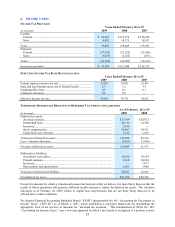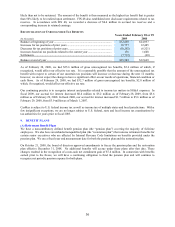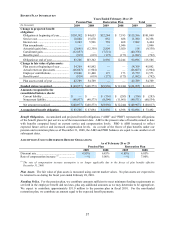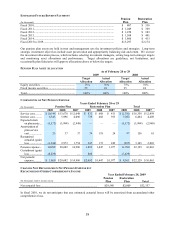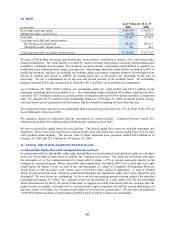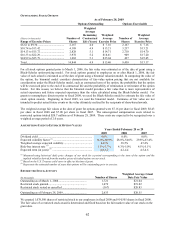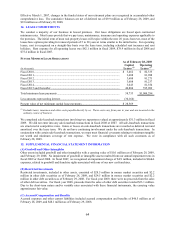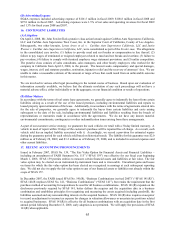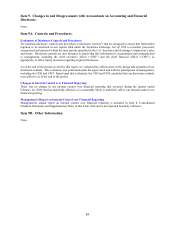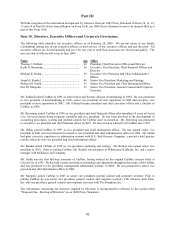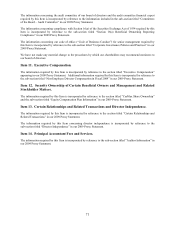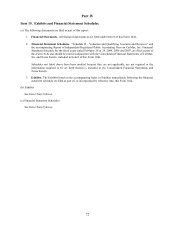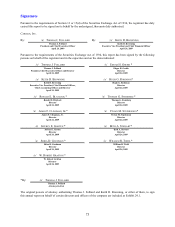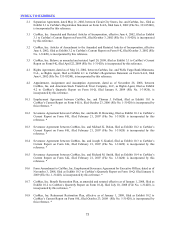CarMax 2009 Annual Report Download - page 71
Download and view the complete annual report
Please find page 71 of the 2009 CarMax annual report below. You can navigate through the pages in the report by either clicking on the pages listed below, or by using the keyword search tool below to find specific information within the annual report.65
(D) Advertising Expense
SG&A expenses included advertising expense of $101.5 million in fiscal 2009, $108.8 million in fiscal 2008 and
$97.8 million in fiscal 2007. Advertising expenses were 1.5% of net sales and operating revenues for fiscal 2009
and 1.3% for fiscal years 2008 and 2007.
16. CONTINGENT LIABILITIES
(A) Litigation
On April 2, 2008, Mr. John Fowler filed a putative class action lawsuit against CarMax Auto Superstores California,
LLC and CarMax Auto Superstores West Coast, Inc. in the Superior Court of California, County of Los Angeles.
Subsequently, two other lawsuits, Leena Areso et al. v. CarMax Auto Superstores California, LLC and Justin
Weaver v. CarMax Auto Superstores California, LLC, were consolidated as part of the Fowler case. The allegations
in the consolidated case involve: (1) failure to provide meal and rest breaks or compensation in lieu thereof; (2)
failure to pay wages of terminated or resigned employees related to meal and rest breaks and overtime; (3) failure to
pay overtime; (4) failure to comply with itemized employee wage statement provisions; and (5) unfair competition.
The putative class consists of sales consultants, sales managers, and other hourly employees who worked for the
company in California from April 2, 2004, to the present. The lawsuit seeks compensatory and special damages,
wages, interest, civil and statutory penalties, restitution, injunctive relief and the recovery of attorneys’ fees. We are
unable to make a reasonable estimate of the amount or range of loss that could result from an unfavorable outcome
in this matter.
We are involved in various other legal proceedings in the normal course of business. Based upon our evaluation of
information currently available, we believe that the ultimate resolution of any such proceedings will not have a
material adverse effect, either individually or in the aggregate, on our financial condition or results of operations.
(B) Other Matters
In accordance with the terms of real estate lease agreements, we generally agree to indemnify the lessor from certain
liabilities arising as a result of the use of the leased premises, including environmental liabilities and repairs to
leased property upon termination of the lease. Additionally, in accordance with the terms of agreements entered into
for the sale of properties, we generally agree to indemnify the buyer from certain liabilities and costs arising
subsequent to the date of the sale, including environmental liabilities and liabilities resulting from the breach of
representations or warranties made in accordance with the agreements. We do not have any known material
environmental commitments, contingencies or other indemnification issues arising from these arrangements.
As part of our customer service strategy, we guarantee the used vehicles we retail with a 30-day limited warranty. A
vehicle in need of repair within 30 days of the customer's purchase will be repaired free of charge. As a result, each
vehicle sold has an implied liability associated with it. Accordingly, we record a provision for estimated repairs
during the guarantee period for each vehicle sold based on historical trends. The liability for this guarantee was $2.0
million as of February 28, 2009, and $3.2 million as of February 29, 2008, and is included in accrued expenses and
other current liabilities.
17. RECENT ACCOUNTING PRONOUNCEMENTS
Issued in February 2007, SFAS No. 159, “The Fair Value Option for Financial Assets and Financial Liabilities –
including an amendment of FASB Statement No. 115” (“SFAS 159”) was effective for our fiscal year beginning
March 1, 2008. SFAS 159 permits entities to measure certain financial assets and liabilities at fair value. The fair
value option may be elected on an instrument-by-instrument basis and is irrevocable. Unrealized gains and losses
on items for which the fair value option has been elected are recognized in earnings at each subsequent reporting
date. We did not elect to apply the fair value option to any of our financial assets or liabilities not already within the
scope of SFAS 157.
In December 2007, the FASB issued SFAS No. 141(R), “Business Combinations (revised 2007)” (“SFAS 141(R)”).
SFAS 141(R) replaces SFAS No. 141, “Business Combinations” (“SFAS 141”), but retains the requirement that the
purchase method of accounting for acquisitions be used for all business combinations. SFAS 141(R) expands on the
disclosures previously required by SFAS 141, better defines the acquirer and the acquisition date in a business
combination and establishes principles for recognizing and measuring the assets acquired (including goodwill), the
liabilities assumed and any noncontrolling interests in the acquired business. SFAS 141(R) also requires an acquirer
to record an adjustment to income tax expense for changes in valuation allowances or uncertain tax positions related
to acquired businesses. SFAS 141(R) is effective for all business combinations with an acquisition date in the first
annual period following December 15, 2008; early adoption is not permitted. We will apply the provisions of SFAS
141(R) when applicable.


